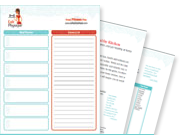You know there’s no magic exercise that’s going to miraculously transform your body in an instant – at least you should know that. But even if you’re not trying to cut corners and you really do plan to put in the hard work, you’d at least like some solid direction on how to get the biggest bang for your buck, right? So which is better for weight loss – cardio or weights? This is a question we get asked all the time, and our answer never changes.
Drumroll here, please….
You need to do both. Were you hoping for a different answer? Don’t worry, you’re not alone, but ideally, you want a combo of moderate to vigorous aerobic exercise and moderate-intensity strength training. The cardio will burn more calories – 10 to 12 per minute for running or cycling, compared to 8 to 10 calories a minute lifting weights. And even if you’re not running, cardio still usually beats out weights when it comes to calories burned because it’s a steady-state activity while most strength routines incorporate many recovery breaks.
Don’t toss your weights to the side just yet though. It can still hold its own. Strength training will increase muscle mass and help rev your metabolism. For every 3 pounds of muscle you build, you’ll burn an extra 120 calories a day while you’re just relaxing because muscle takes more energy to sustain. In other words, cardio fights today’s battle while weights develop a strategy for winning the war. And don’t worry – fitting both into your routine is not as hard as it may seem.
To combine cardio and strength training, you can either build in dedicated weights days and cardio days, or you can combine weights and cardio on the same day, several days a week. Get a minimum of 2.5 hours per week of moderate-intensity aerobic activity, or a minimum of 1.5 hours per week of vigorous-intensity aerobic activity, or a combination of the two. That could mean a brisk walk for 30 minutes a day, five days a week; a high-intensity spinning class one day for 45 minutes, plus a half hour jog another day; or some other combination of moderate and vigorous activity. Doubling the amount of activity (5 hours moderate- or 2-1/2 hours vigorous-intensity aerobic activity) provides even more health benefits. Adults should also aim to do muscle-strengthening activities at least two days a week. Here are 2 sample workouts that will get the job done:
Workout #1
- Day 1 – Cardio (45 min)
- Day 2 – Weights (45 min) – Total body
- Day 3 – Cardio (30 min)
- Day 4 – Cardio (45 min)
- Day 5 – Weights (45 min) – Total body
- Day 6 – Cardio (30 min)
Workout #2
- Day 1 – Cardio (45 min)
- Day 2 – Cardio (25 min), Weights (35 min) – Upper body
- Day 3 – Cardio (45 min)
- Day 4 – Cardio (25 min), Weights (35 min) – Lower body
- Day 5 – Cardio (45 min)
- Day 6 – Cardio (25 min), Weights (35 min) – Total body
Keep in mind that these are just examples; the possibilities are endless. It’s not just one workout that matters but the cumulative effect of your total physical activity across the entire week that gets the job done, and working with a personal trainer is a great way to ensure you get a well-rounded workout every time.


